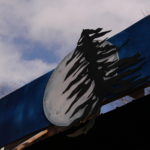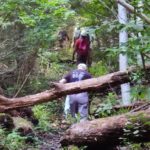Hemlock trees have short, soft green evergreen needles. The Eastern and Carolina Hemlock trees are dying due to a spreading infestation of the Hemlock Woolly Adelgid (HWA), an aphid-like insect native to Asia. Hemlocks are a keystone species and are of great importance to wildlife, water quality, economy, and basic quality of life.
The Problem
The Hemlock Woolly Adelgid is killing the Hemlocks across the Eastern US. This exotic aphid-like insect from Asia infests Hemlocks, sucks their sap, and kills them in 3-6 years. Hemlocks provide cooling shade for trout streams, food for birds, and they hold soil in place so it doesn’t runoff into rivers.
The Woolly Adelgid is native to Asia where predator beetles hold HWA populations in balance. Hemlocks in the western U.S. are unharmed because a native predator beetle keeps the adelgid in check. Eastern Hemlock species have no natural adelgid predators.
The Plan
With an unprecedented degree of collaboration, citizen groups, government agencies, scientists and Georgia’s conservation community are working together to combat HWA. A three-pronged plan has been adopted at the state and federal levels to combat the HWA: Evaluating and implementing biological controls, such as predator beetles; chemical controls for short-term treatment and in locations/situations where these are the best option (such as landscape and some forest settings); and preservation of genetic material for both the Eastern and Carolina Hemlock so that, in the event of a catastrophic impact by HWA, we may be able to restore the Hemlock species in the future. Thanks to the hard work of all concerned, there are now three labs in Georgia — one at Young Harris College, another at UGA, and the newest Predator Beetle Lab at NGCSU — for rearing predator beetles for release on Hemlocks within our public forests. With these successes, Georgia has joined a multi-state effort to find an effective biological control for HWA.
Update! Preliminary results from predator beetle releases indicates that the biological control strategy will be successful. Beetle populations have been established at dozens of sites across North Georgia. These populations are persisting from year to year and are also spreading. Most importantly, the Hemlocks in these areas, while not free of HWA, are looking very healthy.
Why You Should Care
Hemlock stands keep streams cool enough for the fish (particularly trout) to live, and the trees help keep stream banks stable, preventing erosion. The hemlock also provides food and shelter for wild animals and birds, a source that will be gone if we can’t stop the HWA.



